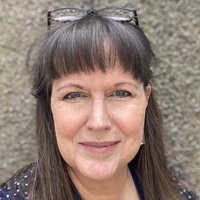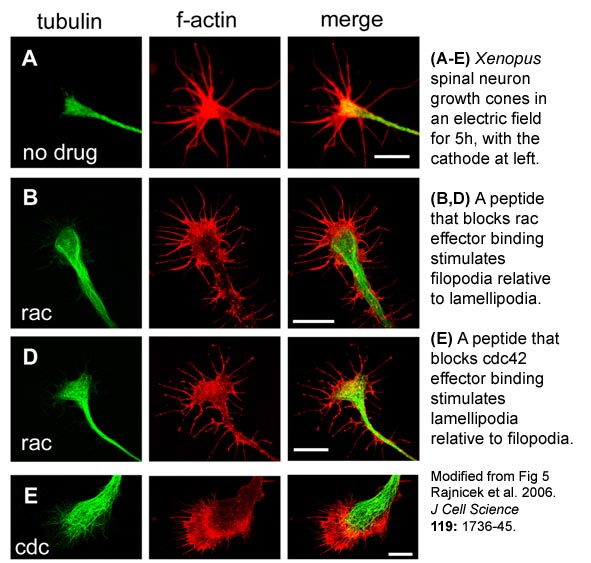
BS, PhD, FRSB
Senior Lecturer
- Email Address
- a.m.rajnicek@abdn.ac.uk
- Telephone Number
- +44 (0)1224 437514
- Office Address
- School/Department
- School of Medicine, Medical Sciences and Nutrition
Qualifications
- BSc Biology1984 - Marygrove College (Detroit, MI USA)
- PhD Developmental Biology1990 - Purdue University (W Lafayette, IN USA)Thesis title: Effects of electric fields on wound healing and directed neurite growth
Memberships and Affiliations
- Chair: School of Medicine, Medical Sciences and Nutrition, Staff Student Liaison Committee, Level 2 courses (2008-present)
- Senior Personal Tutor: School of Medicine ,Medical Sciences and Nutrition (2021-present)
- Co-lead, Co-founder: The IDEALL Group for Equality and Diversity (2016-2021)
- Member: Institute of Medical Sciences Equality, Diversity and Inclusion Committee (2016-present)
- Elected Member: University Senate (2012-2016; 2016-2020; 2023-2026)
- Member: Self Assessment Team, Institute of Medical Sciences Athena Swan Application (2015-2019)
Senior Journal Editor/Media Editor: Bioelectricity (2019-present)(https://home.liebertpub.com/publications/bioelectricity/647)
External examiner: Glasgow University, Molecular and Cellular Biology/Biotechnology/Bioengineering undergraduate degrees (2017-2021)
Fellow: Royal Society of Biology (FRSB)
Member: Society for Neuroscience
Member: British Society for Cell Biology
Member: Scottish Developmental Biology Group
Member: American Society for Cell Biology
Vice Chair: Gordon Research Conference on Bioelectrochemistry (2006)
Chair: Gordon Research Conference on Bioelectrochemistry (2008)
Board Member: Bioelectromagnetics Society (2008-2011)
Council Member: Bioelectrochemical Society (2009-2013)
Prizes and Awards
Yasuda Award for Excellence in Biomedical Research (Jan 2000) Society for Physical Regulation in Biology and Medicine.
Research Overview
I am interested in the process by which cells use environmental conditions as guidance cues during development, wound healing and regeneration. My work has potential applications in tissue engineering and for devising clinical strategies to aid wound healing and nervous system repair.
Guiding cells by DC electric fields
Cells exist within a naturally-occuring electric field, which results from the normal ion transport properties of polarized epithelia. My research addresses the question of how cells use the electric field as a cue to direct cell migration and orientation.
Guiding cells by small substratum contours
The physical shape of the extracellular environment is usually not considered in the context of directional cell migration. However, cells migrate along parallel substratum features on the scale of tens to hundreds of nanometers, which mimic the size of naturally ocurring features (such as individual collagen fibrils or oriented neuronal fibers). I am interested in the process by which individual cells sense very small substratum features and how they translate the cues subsequently into directed migration.
Establishing a guidance heirarchy
Since electric fields and variation in substratum shape co-exist in vivo another interest is to determine the hierarchy of directional cues and the mechanisms that allow the cues to be selected/integrated by individual cells.
Rho GTPases and growth cone guidance by an electric field
The Rho GTPases Rac, Rho and Cdc42 regulate cytoskeletal dynamics spatially and therefore control cell shape and the direction of cell migration. We have shown that Rho GTPase-mediated cytoskeletal dynamics are essential for growth cone guidance by an electric field (Rajnicek et al., 2006 Journal of Cell Science 119:1723-1735; Rajnicek et al. 2006 Journal of Cell Science 119: 1736-45).

Current Research
Growth cone guidance by substratum grooves
Growth cones are exquititely sensitive to substratum features on the scale of tens of nanometers deep but not all types of growth cones respond in the same way to identical features. For example, embryonic rat hippocampal axons align at a right angle to a series of parallel grooves 130 nm deep and 1 um across but Xenopus spinal neuron growth cones migrate parallel to the same grooves. I am currently exploring the intracellular mechanisms growth cones use to detect small substratum features, including roles for Rho GTPases and the transcription factor Pax-6 (collaboration with Martin Collinson and Derryck Shewan, School of Medical Sciences, University of Aberdeen).
Guidance of epithelial cells by substratum nanotopograpy and electric fields is controlled by a rho/cdc42 switch
Cells migrating to re-epithelialise a wound in the cornea migrate over non-planar surfaces within the context of a wound-induced DC electric field. We have shown that corneal epithelial cells migrate parallel to nano-scale substratum grooves and that on planar quartz they migrate toward the cathode of a DC electric field. By simultaneously challenging corneal cells with co-presented substratum grooves and an electric field oriented orthogonally we determined that the electric field was a more potent directional cue and that a cdc42/rho switch controls electrical/contact guidance priority. This is relevant to the design of future therapies to aid wound healing as well as the basic mechanism for how cells sort/select/integrate simultaneous directonal guidance cues present in the normal extracellular environment.
Collaborations
Aberdeen- Prof Nieves Casan-Pastor, Dr W Huang, Dr D Shewan, Dr M Collinson, Dr H Wilson, Prof M Delibegovic
Funding and Grants
IMS Spinal Research Fund -PhD Studentship "Electrical Control of Nerve Cell Growth"
School of Medical Sciences -PhD Studentship "The transcription factor Pax6 and neuronal guidance" (with M Collinson and D Shewan)
European Commission Specific Targeted Research or Innovation Project - "Development of a Bioelectrochemical device for CNS repair" (NERBIOS) ~£220,000 (with C.D. McCaig)
BBSRC - Genetic control of epithelial cell migration and wound healing physiology (with M Collinson, C McCaig and M.Zhao) ~£643,000.
Programmes
- Undergraduate, 4 year, September start
Programme Lead
Courses
Teaching Responsibilities
Course Coordinator:
SM3002- Frontiers of Biomedical Sciences
PY4302 (AN4301)- Developmental Neuroscience (with Anatomy)
AN4002 (AN4003)- Brain Function and Malfunction (with Anatomy)
BM3804- Neuroscience Research Topics
Non-course Teaching Responsibilities
Senior Personal Tutor for School of Medicine, Medical Sciences and Nutrition (undergraduates)
Personal Tutor and related pastoral care for undergraduates
Industrial Placement Tutor
Chair Level 2 undergraduate Staff Student Liaison Committee
Page 5 of 7 Results 41 to 50 of 69
TiO2 surfaces support neuron growth during electric field stimulation
Canillas, M., Moreno, B., Chinnaro, E., Rajnicek, A. M.Materials Science and Engineering C, vol. 79, pp. 1-8Contributions to Journals: ArticlesRequirement of Pax6 for the integration of guidance cues in cell migration
Arocena, M., Rajnicek, A. M., Collinson, J. M.Royal Society Open Science, vol. 4, 170625Contributions to Journals: Articles- [ONLINE] DOI: https://doi.org/10.1098/rsos.170625
- [OPEN ACCESS] http://aura.abdn.ac.uk/bitstream/2164/9465/1/Requirement_of_Pax6_for.pdf
The core planar cell polarity gene, Vangl2, directs adult corneal epithelial cell alignment and migration
Findlay, A. S., Panzica, D. A., Walczysko, P., Holt, A. B., Henderson, D. J., West, J. D., Rajnicek, A. M., Collinson, J. M.Royal Society Open Science, vol. 3, no. 10, 160658Contributions to Journals: Articles- [ONLINE] DOI: https://doi.org/10.1098/rsos.160658
- [OPEN ACCESS] http://aura.abdn.ac.uk/bitstream/2164/7592/1/160658.full.pdf
Contact-mediated control of radial migration of corneal epithelial cells
Walczysko, P., Rajnicek, A. M., Collinson, J. M.Molecular vision, vol. 22, pp. 990-1004Contributions to Journals: ArticlesElectric fields are novel determinants of human macrophage functions
Hoare, J. I., Rajnicek, A. M., McCaig, C. D., Barker, R. N., Wilson, H. M.Journal of Leukocyte Biology, vol. 99, no. 6, pp. 1141-1151Contributions to Journals: Articles- [ONLINE] DOI: https://doi.org/10.1189/jlb.3A0815-390R
Neuronal Growth Cone Guidance by Physiological DC Electric Fields
Rajnicek, A. M.The Physiology of Bioelectricity in Development, Tissue Regeneration and Cancer. 1st edition. CRC Press, pp. 201-232, 32 pagesChapters in Books, Reports and Conference Proceedings: Chapters- [ONLINE] DOI: https://doi.org/10.1201/b10799-15
- [ONLINE] View publication in Scopus
The ciliary GTPase Arl13b regulates cell migration and cell cycle progression
Pruski, M., Rajnicek, A., Yang, Z., Clancy, H., Ding, Y., McCaig, C. D., Lang, B.Cell Adhesion & Migration, vol. 10, no. 4, pp. 393-405Contributions to Journals: ArticlesElectric fields: a novel non-chemical regulator of human macrophage function
Hoare, J. I., Barker, R. N., Mccaig, C. C., Rajnicek, A., Wilson, H. M.Immunology, vol. 143, no. Suppl 2, pp. 96-96Contributions to Journals: Abstracts- [ONLINE] DOI: https://doi.org/10.1111/imm.12406
Ti4O7 used as electrode in biomedicine and for electrochemical study of scavenging mechanism
Canillas, M., Rajnicek, A., Rosero, C., Chinarro, E., Moreno, B.Chapters in Books, Reports and Conference Proceedings: Conference Proceedings- [ONLINE] DOI: https://doi.org/10.4028/www.scientific.net/KEM.493-494.896
- [ONLINE] View publication in Scopus
Interaction between hedgehog signalling and PAX6 dosage mediates maintenance and regeneration of the corneal epithelium
Kucerova, R., Dorà, N., Mort, R. L., Wallace, K., Leiper, L. J., Lowes, C., Neves, C., Walczysko, P., Bruce, F., Fowler, P. A., Rajnicek, A. M., McCaig, C. D., Zhao, M., West, J. D., Collinson, J. M.Molecular vision, vol. 18, pp. 139-150Contributions to Journals: Articles
